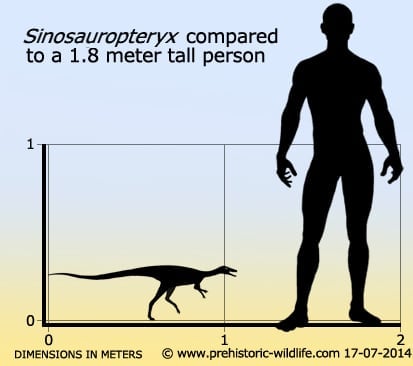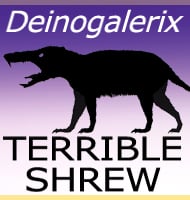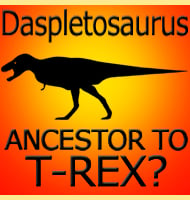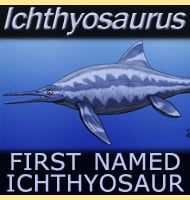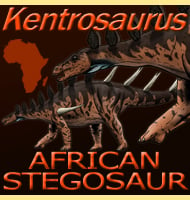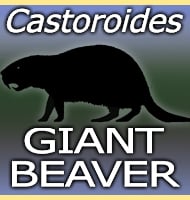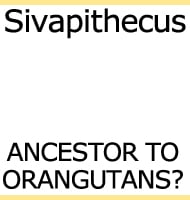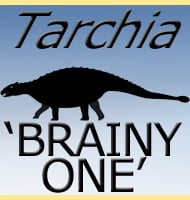In Depth
Sinosauropteryx was the first confirmed feathered but non-avian dinosaur discovered. What this means is that while Sinosauropteryx had protofeathers, it was still more like theropod dinosaurs than birds. Sinosauropteryx is often described as being very small at sixty-eight centimetres long however this measurement was just for the holotype specimen which was a juvenile. Further specimens show Sinosauropteryx to have attained sizes of just over one meter like some other compsognathids. Much of this length is actually the tail and with sixty-four vertebra it is one of the proportionately longest tails in known dinosaurs. Sinosauropteryx is so well preserved that many important internal details can be observed. One of these is the confirmation that dinosaurs, at least those like Sinosauropteryx, had two oviducts, not the one like in modern birds. This is implied by the preservation of two developed eggs that are placed side by side in an area where the oviducts would have been. The eggs themselves are thirty-six by twenty-six millimetres long and wide, and are something that helped confirm the theory that eggs once associated with the related Compsognathus probably did not belong to this dinosaur. This was based upon the observation that while Compsognathus is of a similar size to Sinosauropteryx the eggs in question were only ten millimetres long, much smaller than those found in Sinosauropteryx.
The good preservation of specimens has also revealed what Sinosauropteryx ate. Prey animals included a combination of small lizards and mammals, two of have which have been identified as Sinobaatar and Zhangheotherium, the latter of which had a spur that secreted venom on its foot. Insects may have also formed a part of its diet, particularly when young.
Sinosauropteryx is usually referred to as a feathered dinosaur although the ‘feathers’ themselves were more like filamentous hairs rather than the flight feathers of modern birds. However some have argued against the presence of feathers, with some suggesting that the area around the skeleton is actually the remains of collagen fibres that once supported a sail on top of the animal and below the tail. This was supposedly an adaptation for swimming. Another argued that the feather covering was merely a product of the preparation process.
The overwhelming majority of palaeontologists however agree that Sinosauropteryx had a covering of primitive feathers around its body. One clear observation is that there is a gap between the actual skeleton and feather covering which increases and decreases between different areas where you would expect the bones to be nearer the skin. The hairs also vary randomly in size and are darker on the edges than in the centre indicating that they were hollow as feathers are known to be.
Sinosauropteryx was the first and remains one of the few dinosaurs to have its patterning revealed. An alternating pattern of light and dark bands on the tail was first initially taken to have been caused by the splitting of the slab and counter slab resulting in different amounts of fossil material being divided between the two halves. However in 2002 Longrich pointed out that the bands were very evenly spaced between one another and were probably not the product of the splitting of the slab, but instead represented areas of light and dark pigmentation. Further study as well as observation of further Sinosauropteryx fossils which show similar tail banding has supported this theory. Zhang Fucheng et al. discovered the presence of melanosomes, the cells which dictate the colour of feathers, something that can be observed in the feathers of modern birds. This revealed that the darker areas of pigment were most probably of a chestnut brown colouration.
The main body of Sinosauropteryx also had darker pigment on top of its body, and lighter pigment underneath. Altogether the colouration of Sinosauropteryx seems to have been a defensive adaptation as even though it was a predator, Sinosauropteryx was not the only one, and certainly not the largest active at the time as evidenced by the presence of Sinocalliopteryx. A chestnut brown colouring on top would have allowed Sinosauropteryx to blend into the forest floor while the banding on the tail would have broken up the shape so that it did not immediately look like a tail to a larger predator.
Another dinosaur to have its patterning revealed is Sinornithosaurus, which is also known from the Yixian Formation.
Further Reading
– On discovery of the earliest bird fossil in China (Sinosauropteryx gen. nov.) and the origin of birds. – Chinese Geology (Beijing: Chinese Geological Museum) 10 (233): 30–33. – Q. Ji & S. Ji – 1996. – Implications of soft-tissue preservation in the compsognathid dinosaur, Sinosauropteryx. – Journal of Vertebrate Paleontology 7 (supplement to 3): 48A. – N. R. Geist, T. D. Jones & J. A. Ruben – 1997. – Advances in Sinosauropteryx research. – Chinese Geology 7: 30–32. – Q. Ji & S. Ji – 1997. – An exceptionally well-preserved theropod dinosaur from the Yixian Formation of China. – Nature 391 (8): 147–152. – P. Chen, Z. Dong & S. Zhen – 1998. – Anatomy of Sinosauropteryx prima from Liaoning, northeastern China. – Canadian Journal of Earth Sciences 38 (1): 705–727. – P. J. Currie & P. -J. Chen – 2001. – Systematics of Sinosauropteryx. – Journal of Vertebrate Paleontology 22 (supplement to 3): 80A. – N. Longrich – 2002. – New material of Sinosauropteryx (Theropoda: Compsognathidae) from western Liaoning, China. – Acta Geologica Sinica (English Edition) 81 (2): 177–182. – S. Ji, C. Gao, J. Liu, Q. Meng & Q. Ji – 2007. – A new Chinese specimen indicates that ‘protofeathers’ in the Early Cretaceous theropod dinosaur Sinosauropteryx are degraded collagen fibres. – Proceedings of the Royal Society B 274 (1620): 1823–1829. – T. Lingham-Soliar, A. Feduccia & X. Wang – 2007. – Fossilized melanosomes and the colour of Cretaceous dinosaurs and birds. – Nature 463 (7284): 1075–1078. – X. Xu & X. Wang – 2010.- Additional information on the primitive contour and wing feathering of paravian dinosaurs. – Palaeontology. 61 (2): 273–288. – Evan T. Saitta, Rebecca Gelernte & Jakob Vinther – 2018.
